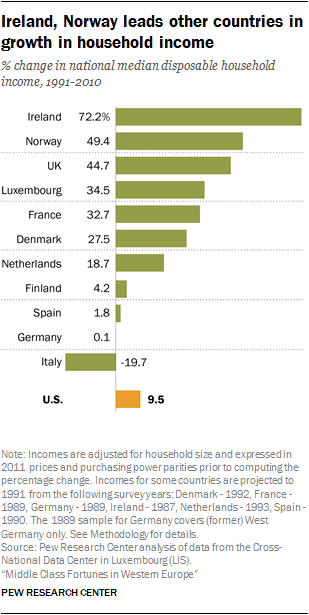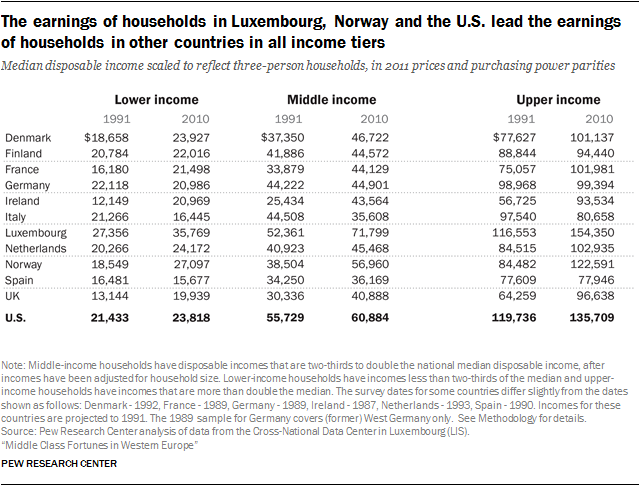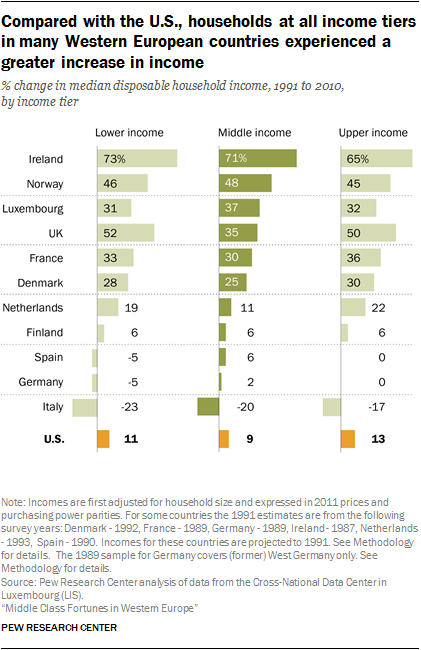The financial well-being of lower-, middle- and upper-income tiers varies significantly across the selected Western European countries and the U.S. There are also notable differences in how the disposable incomes of the three economic tiers have changed over time. Households in some countries, such as Ireland, experienced sizable gains in their standard of living, but households in Italy saw their standard of living erode since 1991.21

Overall, Luxembourg, the Netherlands, Denmark and Norway had the highest median disposable household incomes among the selected Western European countries in 2010, followed by Germany, France and Finland in the middle and Spain, Italy, the UK and Ireland trailing behind. Middle-income and upper-income households in the U.S. fared better than their counterparts in the Western European countries examined, except for Luxembourg. However, the incomes of lower-income households in the U.S. lagged behind those of several Western European countries from among those examined.22
From 1991 to 2010, Ireland, Norway and the UK led other countries in raising the incomes of households overall and of households within each income tier.23 Meanwhile, the incomes of households in Italy fell significantly and were virtually unchanged in Germany and Spain. Income growth in the U.S. was slower than in the majority of countries selected from Western Europe.
Wide gaps in household income among the selected countries
Luxembourg had the distinction of having the highest national median household income among the countries covered in this report. From 1991 to 2013, in all years examined, the median income in Luxembourg was about twice as high as the median income of lower-earning countries from among the selected Western European countries. Thus, even within this group of advanced economies, there is a wide gap in earnings across countries.
In 1991, the median household income in Luxembourg was $48,657, about the same as in the U.S. ($48,343). Only two other selected countries – Germany and Italy – had median incomes higher than $40,000 in 1991. Ireland’s median income of $22,684 was less than half that of Luxembourg. The UK, with a median of $26,145, also trailed Luxembourg by a wide margin.

By 2010, Luxembourg still held the topmost spot, while the lowest rungs of the income ladder were occupied by Italy and Spain. The median income in Spain in 2010 – $31,885 – was nearly the same as in 1991, but the median income in Italy slipped from $40,265 in 1991 to $32,353 in 2010, a loss of 20%.24 Meanwhile, strong income growth in Ireland – from a median of $22,684 to $39,067, an increase of 72% – and in the UK – from $26,145 to $37,826, up 45% – pushed households in those countries up in the ranking based on median income.
Norway (49%), France (33%) and Denmark (27%) also registered strong growth in real incomes from 1991 to 2010. The median income in the U.S. increased only 10%, from $48,343 in 1991 to $52,941 in 2010. As a result, the U.S., which was tied with Luxembourg ($48,657) with the highest median income in 1991, was matched by Norway ($52,304) in 2010 and fell well short of Luxembourg ($65,466).
Most countries continued to feel the lingering effects of the Great Recession through 2013. Incomes were unchanged in Finland, Germany, Luxembourg, Spain, the UK and the U.S. from 2010 to 2013, but households in the Netherlands saw their median income fall from $43,192 in 2010 to $41,083 in 2013. (See Appendix A for estimates for 2013.)
Norway experienced a milder recession compared with the other countries examined and its economy recovered more quickly.25 Thus, Norway stands out as an exception in the post-recession period, lifting the median income of its households from $52,304 in 2010 to $57,031 in 2013. By 2013, the typical household in Norway lived on about $5,000 more annually than the typical U.S. household.
Middle-class incomes are among the highest in the U.S., but lower-income Americans trail many Western European nations
In 2010, the median disposable income of the American middle class was higher than the median of the middle classes in many of the Western European nations examined, trailing only Luxembourg. In that year, middle-class households in the U.S. lived on a median disposable income of $60,884, compared with $71,799 in Luxembourg. However, by 2013, the middle class in Norway had also pulled ahead of the American middle class, earning a median of $62,014 compared with $59,940 in the U.S.
The middle classes in Italy and Spain earned less than the others in most of the years examined. In Spain, middle-class incomes were virtually stagnant, standing at $34,250 in 1991 and at $35,879 in 2013. In Italy, the median income of middle-class household fell sharply, from $44,508 in 1991 to $35,608 in 2010, the latest year available. Middle-class households in Finland and Germany also experienced modest growth in their incomes from 1991 to 2013. (See Appendix A for estimates for 2013.)
The earnings of upper-income households varied similarly across countries. The upper-income tier in Luxembourg stood at the top, with a median income of $154,350 in 2010, followed by $135,709 in the U.S. Upper-income households in Spain ($77,946 at the median) and Italy ($80,658) earned half as much as upper-income households in Luxembourg in 2010. These standings are mostly unchanged since 1991.
Lower-income households in several countries in Western Europe earn more than lower-income households in the U.S. In 2010, the median income of lower-income households in Denmark ($23,927), the Netherlands ($24,172), Norway ($27,097) and Luxembourg ($35,769) matched or exceeded the median in the U.S. ($23,818). At the same time, the median income of lower-income households in Finland, France, Germany, Ireland and the UK – about $20,000 or higher – did not trail the U.S. by much.

Middle-class incomes are rising, but gains for upper-income households are greater in several countries

Ireland outpaced other countries in terms of income growth from 1991 to 2010, whether for the lower-, middle- or upper-income tier. In sharp contrast, all income tiers in Italy experienced a steep drop in median income, and lower-income households in Spain and Germany experienced modest losses. Meanwhile, the financial status of middle-income households slipped relative to the status of upper-income households in many countries during this period.
Middle-class households in Ireland experienced a gain of 71% in their median income from 1991 to 2010. This was well ahead of the increase of 48% for the middle class in Norway, or the increase of 37% in Luxembourg and 35% in the UK. However, in Italy, the middle class experienced a loss of 20% in their median income from 1991 to 2010.
The growth in middle-class incomes often exceeded the growth for upper-income households from 1991 to 2010. This was the case in Ireland, where the median income increased 71% for the middle class and 65% for the upper-income tier. Middle-class households also narrowed the financial gap compared with upper-income households in Germany, Luxembourg, Norway and Spain.
However, middle-income households lost financial ground to upper-income households in several countries from 1991 to 2010. This was most notable in the UK, where the increase in the median income for upper-income households (50%) was much greater than the gain for middle-income households (35%). Also, the gain for upper-income households in the Netherlands (22%) was much greater than the gain for middle-income households (11%).
Gains or losses for the lower-income tier are generally similar to the gains or losses for the other income tiers. Ireland and the UK ranked at the top, with the median incomes of the lower-income tiers rising 73% and 52% from 1991 to 2010, respectively. Lower-income tiers also experienced significant growth in incomes in Denmark, France, Luxembourg and Norway. But the median income of lower-income tiers in Germany and Spain fell by 5%. Even so, that was significantly less than the 23% loss in income experienced by the lower-income tier in Italy.
Monetary gains for all income tiers in the U.S. were relatively modest compared with most Western European countries examined. Lower-, middle- and upper-income tiers in Denmark, France, Ireland, Luxembourg, the Netherlands, Norway and the UK all experienced greater income growth from 1991 to 2010 than their counterparts in the U.S. But all income tiers in the U.S. realized more income growth than the corresponding tiers in Finland, Germany, Italy and Spain.




